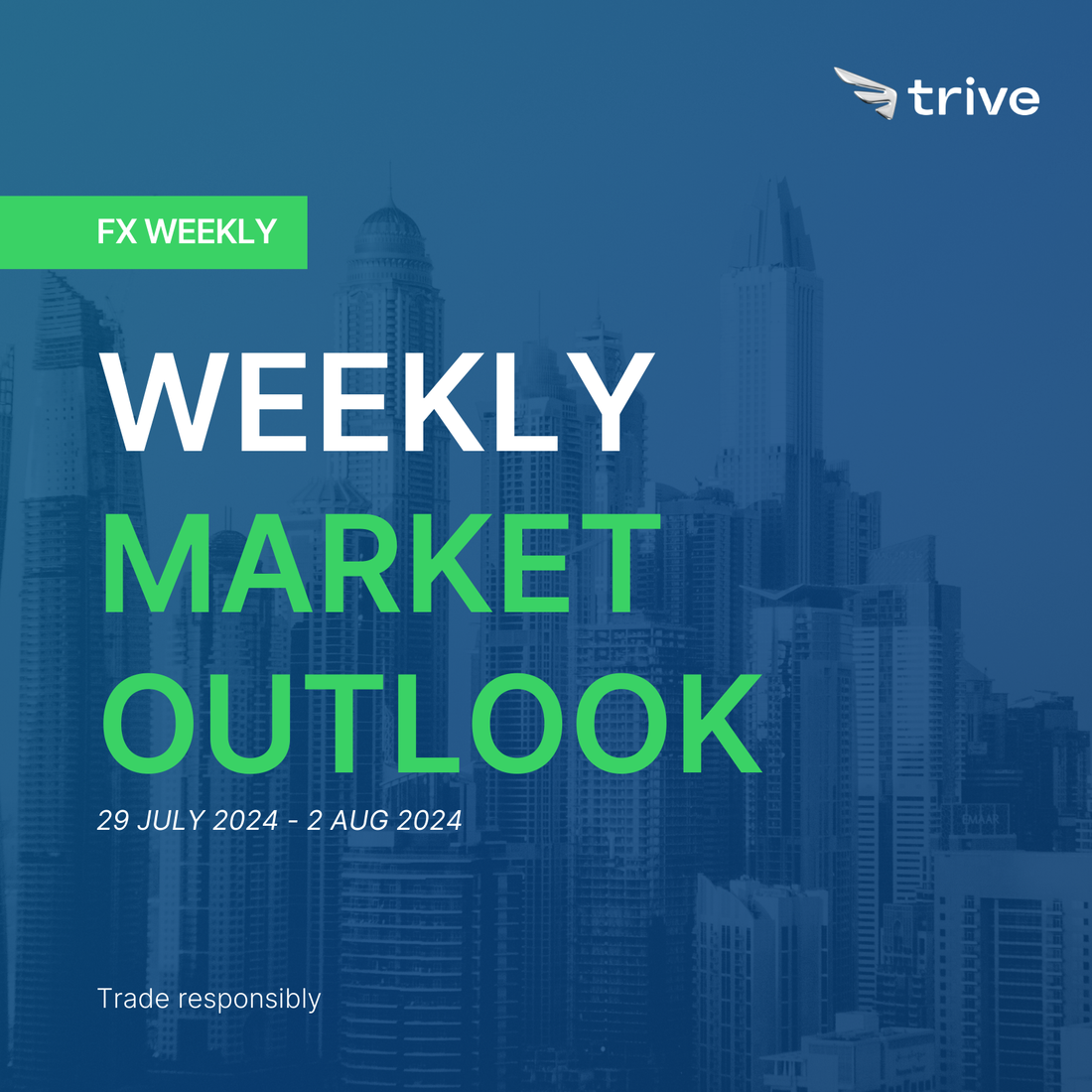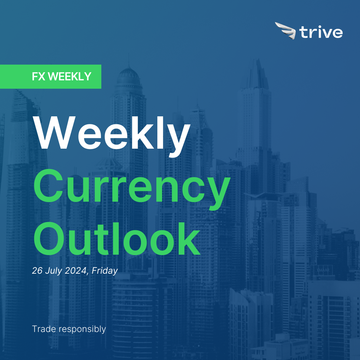FX Weekly: Trive’s Week Ahead Insights

This week will be one of the busiest weeks of the year, with lots of economic data on the agenda and the BoJ, the Fed and BoE releasing their policy decisions.
Eurozone Flash Q2 GDP-Tuesday
Expectations are for Q/Q GDP to slow to 0.2% from 0.3% with the Y/Y rate seen rising to 0.6% from 0.4%. As a reminder, growth in Q1 picked up to 0.3% from 0.0% with ING making the observation that the region was able to benefit from more stable energy prices, lower inflation and stronger wage growth. This time around, analysts at Investec, expect a positive growth outturn for the Eurozone which would be the first back-to-back quarterly GDP increase since 2022. That being said, growth is expected to slow on account of ongoing weakness in industrial output, particularly in the likes of Germany. In terms of a broader outlook for the year, Investecnotes that it expects the “Euro area’s economic recovery will become more entrenched over the year. Helping this will be an improving household income backdrop and lower interest rates, a prospect which is beginning to prompt some improvement in credit conditions”.
Quarterly Refunding-Wednesday
The Treasury will announce next quarter's issuance sizes on Wednesday 31st July. At the last refunding, the Treasury announced USD 125bln of refunding, comprising USD 58bln in 3yr notes, USD 42bln in 10yr notes and USD 25bln in 30yrbonds. It also noted in its projections, that the "Treasury believes these cumulative changes leave it well positioned to address potential changes to the fiscal outlook and to the pace and duration of future SOMA redemptions." adding that "Based on current projected borrowing needs, Treasury does not anticipate needing to increase nominal coupon or FRN auction sizes for at least the next several quarters."
Analysts at Wells Fargo expect coupon auction sizes to remain unchanged for the second consecutive quarter. However, they will be looking for developments on potential guidance for the reinstatement of the debt ceiling. The desk notes that the debt ceiling is currently suspended, and absent congressional action, it will be reinstated on 2nd January 2025. It is also worth noting we will be looking for an update on the treasury's buybacks too. The prior refunding noted the Treasury will seek offers for no more than 20 CUSIPs, due to temporary settlementprocess limitations. Once these issues are addressed, the 20 CUSIP cap will be removed, and they plan to move towards operation sizes consistent with prior guidance - Treasury said it will provide an update on this transition at this upcoming refunding.
FOMC Announcement-Wednesday
The FOMC is expected to keep rates unchanged at 5.25-5.50% in August. While price pressures have eased recently, and there have been signs of a labour market slowdown, officials appear in no rush to cut rates, with some still wanting greater confidence that inflation would fall to target sustainably. Economists and market-based pricing expect officials will have this greater confidence by the September 18th meeting, where money markets have fully discounted a 25bps rate reduction to 5.00-5.25%; additionally, money markets fully price the Fed cutting rates again by the end of this year and are assigning around a 50% probability of a third rate cut. That is in contrast with the Fed's June economic projections, where policymakers pencilled in just one cut this year. The Fed is also facing pressure from former officials who have urged the central bank to cut rates in August.
Former NY Fed President Dudley recently revised his higher-for-longer view', arguing that the Fed should begin the cutting now; he said the Fed’s efforts to cool the economy were now having a visible effect, noting that most Americans had now depleted what they managed to save from the government’s huge fiscal transfers, and they’re feeling the impact of higher rates on credit cards and auto loans, while housing construction has faltered, and economic momentum generated by Biden’s investment initiatives appear to be fading. Dudley also noted that the three-month average unemployment rate is up0.43ppts from the low seen in the last 12 months, close to the 0.5 threshold that, as identified by the Sahm Rule, signals a recession. Dudley also argued that inflation pressures have abated significantly after a series of upside surprises earlier this year, and are not too far away now from the Fed’s target.
Current Interest Rate Probability of Fed

Bank of Japan Announcement-Wednesday

A majority of surveyed economists expect the policy rate to be kept at 0.0%-0.1% whilst money markets are currently pricing a 47% chance of a 15bps hike. The BoJ is also set to announce its taper plans and will release the latest Outlook report containing board members’ median forecasts for Real GDP and Core CPI. 76% of economists expect the BoJ to keep rates unchanged and 59% expect the BoJ to taper bond purchases to around JPY 5tln per month as a first step at the July meeting. Furthermore, economists are split over which month the BoJ will hike rates as 43% think October, 30% think September and only 24% think July, while a recent source report noted the BoJ is to weigh a rate hike at next week’s meeting and will have a detailed plan to halve the bond buying in the coming years with purchases to be tapered gradually at a pace near market consensus. The source report also noted that a July rate hike decision is a close call with the consumption outlook key and was also described as a judgment call in terms of acting now or later in the year.
A prior source report had also stated that the BoJ is said to see weak consumption complicating its rate decision with officials likely to wait until the last minute to finalise their decision after checking the latest data on markets and economic conditions at next week’s meeting with some officials wanting more time to see the data and other officials seeing risks the BoJ could miss the chance to lift rates although sources added that the central bank don’t intend to cause any major surprise. As a reminder, the BoJ kept its short-term policy rate unchanged at 0.0%-0.1% in the June meeting which was widely expected, although it caught markets off-guard by defying expectations for the central bank to announce an immediate tapering of its bond purchases and instead kicked the can down the road as it declared it is to trim purchases but will decide on a specific bond-buying reduction plan for the next 1-2 years at this month’s meeting.
Furthermore, BoJ Governor Ueda said during the post-meeting press conference that the reduction of JGB purchases will be a considerable volume and they will start a reduction of JGB purchases immediately after deciding at the July meeting, as well as noting that a July hike is naturally possible depending on the data. The central bank has since held a meeting with bond market participants to provide them with a chance to convey their views before it announces its tapering plans, and received various views from participants on the amount, pace and guidance for the JGB purchase reduction such as trimming purchases to around JPY 2tln-3tln and an opinion that a reduction in the number of monthly purchases to about JPY 3tln would be a clear message that it is committed to a significant reduction, while some favoured a more forceful approach of trimming purchases to JPY 1tln2tln and others urged a less aggressive taper to JPY 4tln or even to JPY 5tln before shifting to a larger reduction.
However, it remains to be seen what the central bank will actually decide for its bond tapering plans as BoJ officials haven’t provided any specific clues of the magnitude of its upcoming tapering and were reportedly more interested in hearing market views in the bond market meetings rather than forming discussions around specific options for bond purchase reductions. Next week’s meeting will also include the latest Outlook although the board projections will take a back seat to the actual decision on rates and the BoJ’s tapering plans.
China PMI-Wednesday
There are currently no expectations for the release, but the data will be closely watched to gauge the health of the Chinese economy at a time of slowdown concerns. In terms of the prior month’s release, the official PMI showed a contraction in broad manufacturing activity for the second consecutive month, highlighting weak domestic demand and trade frictions. This diverged from the Caixin release which showed manufacturing PMI topping forecasts and reaching the highest since May 2021.
According to CapitalEconomics, the mixed PMIs suggest a loss of economic recovery momentum in June, potentially influenced by negative sentiment from recent US and EU tariff announcements. Since then, the PBoC announced a series of rate cuts, to the RRR, LPR, SLF, and MLF after the CPP’s Third Plenum under-delivered on the sought-after economic support measures several desks were expecting. As a side note, the fallout of Typhoon Gaemi is yet to be seen as it hits China (at the time of writing) after battering Taiwan and the Philippines – albeit may not be encapsulated in the PMI survey period.
Australian CPI-Wednesday
Westpac expects the Australian Q2 CPI to remain steady at 1.0% Q/Q and 3.8% Y/Y, in line with market forecasts. The Trimmed Mean CPI is projected to rise by 0.9% Q/Q, a slight cooling from the 1.0% increase in the March quarter, which keeps the annual pace steady at 4.0%. The Weighted Median is forecasted to increase by 1.0% Q/Q, down from 1.1% in Q1, maintaining an annual rate of 4.4%. Energy prices are a notable uncertainty, particularly the impact of energy rebates on electricity prices. Auto fuel prices, expected to fall by 1.2% in June, contribute to a quarterly increase of 1.0%. Clothing and footwear prices are forecasted to rise by 2.9% Q/Q due to seasonal factors. Outside of electricity, both rent and the purchase of dwellings remain key sources of inflationary pressure, the bank said and is anticipated to increase by 1.3% Q/Q.
The last RBA meeting was in June, with no gathering in July and the next confab on 5-6th August.RBA Minutes from the June meeting stated the Board judged the case for holding rates steady was stronger than the case for hiking, adding they needed to be vigilant to upside risks in inflation and data suggested upside risk for May CPI (which came in hotter than expected). The board judged it is still possible to bring inflation to target while keeping employment gains. The minutes also noted that a rate hike might be needed if the board judged policy was not "sufficiently restrictive" while noting inflation expectations are still anchored.
Eurozone Flash CPI-Wednesday
Expectations are for headline Y/Y CPI to decline to 2.4% from 2.5% with the super-core metric seen pulling back to 2.8% from 2.9%. As a reminder, the prior release failed to change the outlook for the ECB with the core reading unchanged from the prior and the services print at an elevated 4.1%. This time around, analysts at Oxford Economics expect another pullback in price pressures which could pave the way for an additional rate cut in September.
That being said, given there is one more inflation report before the September meeting, the upcoming report is unlikely to seal the deal for the ECB’s next decision. Markets will more likely be guided by rhetoric from officials ahead of the September meeting with expectations needing to be managed given that the odds of a cut vs. unchanged stand at 56% and 46% respectively.
Bank of England Announcement-Thursday

The consensus amongst analysts (49/60) is for the BoE to kick off its rate-cutting cycle with a 25bps reduction in the Base Rate to 5.0%. Markets are less sure of the outcome of the decision with the choice between a cut and an unchanged rate seen as anear coinflip. In terms of the vote split for the decision, surveyed analysts anticipate a close 5-4 decision to cut rates (range is between 2votes for a cut and 6) vs. the 7-2 vote split in favour of unchanged at the June meeting. As a reminder, the June decision for “some” on the MPC was “finely balanced”.
In terms of economic developments since the prior meeting, headline Y/Y CPI for June remained at the MPC’s2% target, however, the services metric held steady at 5.7% vs. the MPC forecast of 5.1%. Albeit, some of the upsides were attributed to volatile hotel prices at a small number of hotels. On the growth front, M/M GDP exceeded expectations, printing at 0.4% vs. Exp. 0.2%. More timely PMI data from S&P Global showed a composite reading of 52.7 with services and manufacturing both in expansionary territory. In the labour market, there have been further signs of loosening, however, headline 3M/YY average earnings remain at an elevated rate at 5.7%. Rhetoric since the prior meeting has been limited.
However, what we have heard from the MPC via the likes of Mann, Haskel and Pill has primarily learnt in a hawkish direction with Chief Economist Pill’s words carrying the largest weight. Pill remarked that “we have to be realistic about how much any one or two releases can add to our assessment."
Overall, given the mixed data and lack of clear guidance from some of the core MPC members, any calls by desks are seen as low-conviction ones. In the event that the MPC opts to stand pat on policy, they could opt to tweak existence guidance which notes that “…policy will need to remain restrictive for sufficiently long”. In terms of market pricing for 2024, two rate cuts are fully priced by year-end. For the accompanying macro projections, ING notes that a decline in market rates since the May MPR will likely translate into upside revisions to growth and inflation.
OPEC+JMMC-Thursday
OPEC+ ministers are set to meet online on August 1st for a joint ministerial monitoring committee (JMMC) meeting. This will not be a policy-setting ministerial meeting. Sources indicate the meeting is unlikely to recommend changes to the current output policy. In terms of current policy, OPEC+ is cutting output by 5.86mln BPD.
The group plans to start unwinding a 2.2mln BPD cut from October 2024 to September 2025. In June, OPEC+ extended cuts of 3.66mln BPD until the end of 2025 and prolonged the 2.2mln BPD cut by three months until September 2024. In terms of prior commentary, Russian Deputy PM Novak mentioned the possibility of tweaks to the agreement if market conditions require, whilst Saudi Energy Minister Abdulaziz bin Salman previously stated that OPEC+ could pause or reverse production hikes if the market isn't strong enough.
This comes in the context of persistently weak oil prices, with desks citing sluggish Chinese demand as one of the main factors. One area that could see some interest is the compensation plans. Russia submitted a schedule to the OPEC secretariat for compensating its overproduction. Cumulative overproduction from January to June was 480k BPD. Russia plans to offset 40k BPD of overproduction in October-November 2024 and 440k BPD in March-September 2025.
US ISM Manufacturing PMI-Thursday
The consensus looks for the headline ISM Manufacturing PMI to rise slightly to 48.8 in July (vs 48.5in June). As a gauge of comparison, S&P Global's flash PMI data for the month showed the manufacturing PMI falling to a 7-month low of 49.5 in July from 51.6 in June, while the manufacturing output index fell to a 6-month low of 49.5 from 52.1 in June.
S&P Global said the data signalled a deterioration in business conditions within the goods-producing sector for the first time since December. "Falls in new orders, production and inventories contributed to the decline in the PMI, the former dropping especially sharply," it noted, "a reduced rate of employment growth also acted as a drag on the PMI." Meanwhile, the report notes that supplier delivery times lengthened marginally, acting as a positive influence for a second month, though the lengthening was only marginal.
US Job Report-Friday
The consensus expects 185k nonfarm payrolls will be added to the US economy in July (vs 206k in June, vs 3mth avg of 177k, 6mth avg of 222k, and 12mth avg of 218k). The unemployment rate is expected to hold at 4.1% (vs FOMC June projections of 4.0% in 2024). Former NY Fed President Dudley recently noted that the three-month average unemployment rate is up 0.43ppts from the low seen in the last 12 months, which is close to the 0.5 threshold that the 'Sahm Rule' identifies as a recession signal. Other analysts have looked through the potential signal; Capital Economics said that "even if the unemployment rate continues to rise by another 0.1ptts in July, the Sahm rule is highly unlikely to be triggered, as the earlier low of 3.5% in July 2023 drops out of the 12-month comparison period, and is replaced with a higher value of 3.7%."
Additionally, CapEco argues that the recent rise in unemployment has been driven by falls in employment among those aged 16-24, as weaker hiring intentions hinder their ability to find summer jobs. "July is typically another strong month for hiring, so employment is likely to struggle in seasonally adjusted terms, keeping the unemployment rate at 4.1%," CapEco says, but"this distortion will unwind in September when students return to education."
Elsewhere, the rate of average hourly earnings is again likely to print +0.3% M/M in July. Still, analysts will be looking to the Fed's preferred gauge of wages, the Employment Cost Index, which is released on 31st July (before the NFP data); that series rose to 4.5% in Q1, and signs that it is continuing to decline could be more influential than the BLS wage stats sue in the Employment Situation report, some have suggested.
Ahead, analysts note that the BLS will release its annual benchmark revisions to the payrolls data on August 21st, as well as its Quarterly Census of Employment & Wages; "the sizeable divergence between the QCEW and nonfarm payroll figures suggest that the estimate will point to a sharp downward revision – although the data won’t formally changed until early next year," Capital Economics says, adding that "if more of the strength in payroll gains earlier this year was expected to be revised away, that would remove another potential barrier to interest rate cuts."
Disclaimer
This material is provided for informational purposes only and does not constitute financial, investment, or other advice. The opinions expressed in this material are those of the author and do not necessarily reflect the views of Trive International. No opinion contained in this material constitutes a recommendation by Trive International or its author regarding any particular investment, transaction, or investment strategy. This material should not be relied upon in making any investment decision.
The information provided does not consider the individual investment objectives, financial situation, or needs of any specific investor. Investors should seek independent financial advice tailored to their individual circumstances before making any investment decisions. Trive International shall not be liable for any loss, damage, or injury arising directly or indirectly from the use of this information or from any action or decision taken as a result of using this material.
Trive International may or may not have a financial interest in the companies or securities mentioned. The value of investments may fluctuate, and investors may not get back the amount they originally invested. Past performance is not indicative of future results.
For more information about Trive International, please visit http://trive.com/int
Additional Information
Investing involves risk, including the potential loss of principal. Diversification and asset allocation strategies do not ensure a profit or guarantee against loss. The content in this material is subject to change without notice and may become outdated or inaccurate over time. Trive International does not undertake any obligation to update the information in this material.
By accessing this material, you acknowledge and agree to the terms of this disclaimer. If you do not agree with these terms, please refrain from using this information.
No comments
Home
Trive
TriveHub





0 comments